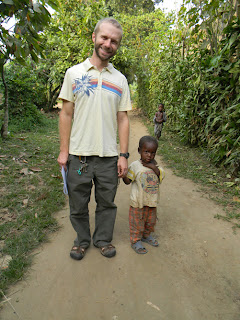So it doesn’t escape my thoughts that I live in a rainforest. It’s just sometimes I remember it more than others. So the past two weeks we have had a deluge of rain and not the 5 minute afternoon rain shower variety – I’m talking the all night thunderstorm where the lightning feels like it’s in your bedroom and you wake up to find out that the water is in your bedroom. This happened to one of our mission houses this weekend.

(Chrissy modeling the gumboots in the house look)

It turns out that the water level outside the house was about 4 inches above the soil line at the back of the house which created a not so good situation hydraulically with the shower soak pit allowing water to backflow into the house via the shower drain. Beyond house flooding, the rains have made one of my other occasional tasks – air traffic controller – significantly more difficult. About a week ago, I spent the entire day coordinating with MAF Uganda to get a plane in and out of our airstrip under less than ideal conditions.

(The MAF pilot did an AMAZING job landing through the mud)
The whole day was definitely an adventure and when the pilot stepped out of the plane and asked, “hey, did you get that on video,” it pretty much affirmed to me that it wasn’t every day you land in that kind of mud.
****
One of the harder things about these rains has been the whole climate of this region this year. This past dry season in Jan-Feb was MUCH drier than normal (it didn’t rain once for over 35 days!). This really affected the food gardens that so many people rely on here. The drought caused local food to run out quickly and people here quickly ran out of money to buy imported food. This has affected all of life and many students haven’t been able to pay school fees for the second term as a result (I believe that Christ School Bundibugyo, the secondary school that WHM runs, had only received about 33% of student fees a week before the term ended – it’s really left our mission trying to scramble to keep the school open by paying the Ugandan teachers salaries and have food for the students. It’s pretty much on crisis fundraising mode just to be able to open up again for the final term of the year in August. If you would like to help out the school, it might be one of the best ways that you could use your money: http://www.whm.org/project/details?ID=11024)
In March the rains began coming regularly, and we all rejoiced in what we were hoping would be a bountiful local harvest about 3-5 months later (depending on crops). The problem has been that the rains, which should have slowed to about 1/week in June/July, haven’t stopped. In fact, they’ve increased. The past two weeks have been completely overcast with a major rainstorm about once/day. I have a friend whose garden was washed away in a combination flood landslide that happened this weekend.

(This is the view from above my friends food garden. He lost all of his g-nuts and beans, and some of his bananas)
I went with him to his garden just to mourn the loss with him. Many others I’ve talked to have suffered the same thing or had what was left in their gardens slowly stolen by thieves (who are likely neighbors who had their crops destroyed). It makes life here heavy sometimes as we move from crisis to crisis.
****
The newest crisis to come to Uganda is a new Ebola outbreak (http://www.npr.org/blogs/health/2012/07/31/157647569/as-ebola-cases-rise-in-uganda-health-workers-seek-to-contain-virus?ps=sh_sthdl). I’ve known about it for a week now (or maybe it seems like a week as a few days can seem like a long time). It’s sad and hard. People here remember so freshly when Ebola was in Bundibugyo in 2007. I remember how it affected my missionary friends and how we lost a really good Ugandan friend I had worked with during my summer internship. Here, we are praying for those in Kibaale district and for God’s protection and isolation of this highly infectious and deadly disease.
****
I would love your continued prayers for me and for Bundibugyo. I haven’t even been able to get into the details or frustrations on the water project, or how I pulled a muscle and/or bruised a rib last week (and it still hurts), or how my truck is still delayed in Kampala, or how 3-5 people come to my door per day looking for food/work/money. Ministry is hard here and it is so easy to become weary.
****
“He who dwells in the shelter of the Most High
will abide in the shadow of the Almighty.
I will say to the LORD, ‘My refuge and my fortress,
my God, in whom I trust,’
For he will deliver you from the snare of the fowler
and from the deadly pestilence.
He will cover you with his pinions,
and under his wings you will find refuge;
his faithfulness is a shield and buckler.”
Psalm 91: 1-4























